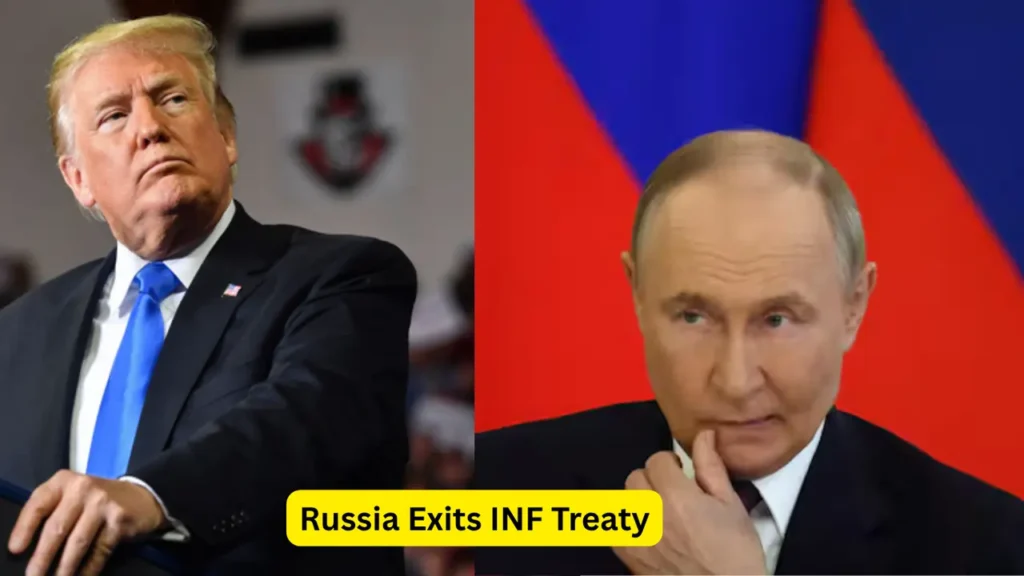New Delhi: In a move that has reignited fears of a Cold War-style arms race, Russia announced on August 5, 2025, that it no longer considers itself bound by the 1987 Intermediate-Range Nuclear Forces (INF) Treaty. This landmark arms control agreement, signed between the United States and the Soviet Union, banned ground-launched ballistic and cruise missiles with ranges between 500 and 5,500 kilometers (311 to 3,418 miles). The decision marks a significant escalation in global tensions, further eroding the framework of nuclear arms control and raising concerns about heightened nuclear risks and global instability.

Background of the INF Treaty
The INF Treaty, signed in 1987 by U.S. President Ronald Reagan and Soviet leader Mikhail Gorbachev, was a cornerstone of Cold War arms control. It was the first major agreement to eliminate an entire class of nuclear and conventional weapons, requiring the destruction of all ground-launched missiles within the specified range. The treaty also allowed for on-site inspections to verify compliance, a groundbreaking step in fostering trust between the two superpowers.
As part of the treaty, the United States destroyed 846 missiles, while the Soviet Union demolished 1,846. This disarmament effort significantly reduced the risk of a rapid-escalation nuclear conflict in Europe, where such missiles were primarily deployed. Unlike air-launched or sea-launched weapons, ground-launched missiles posed a unique threat due to their short flight times, which increased the risk of miscalculation or false launch warnings.
The treaty remained a pillar of global security until 2019, when the United States withdrew, citing Russian non-compliance. The U.S. accused Russia of developing and deploying the Novator 9M729 missile system (designated SSC-X-8 by NATO), which it claimed violated the treaty’s range restrictions. Russia denied these allegations, asserting that the missile’s range of 500 kilometers fell within the treaty’s limits. Moscow also accused the U.S. of developing prohibited missile systems, further straining the agreement.
Russia’s Withdrawal: Reasons and Context
Russia’s decision to exit the INF Treaty comes amid escalating tensions with the United States and its NATO allies. The Russian Foreign Ministry stated that the conditions for maintaining a unilateral moratorium on deploying such missiles had “disappeared.” Moscow pointed to recent U.S. military actions as the primary justification for its withdrawal, accusing the West of creating a “direct threat” to Russia’s national security.
Key among these actions was the U.S. deployment of the Typhon missile system in the Philippines and missile drills conducted during the Talisman Sabre exercises in Australia. Russia also expressed concern over a planned U.S. missile deployment in Germany, set to begin in 2026. These moves, according to Moscow, represent a destabilizing buildup of missile capabilities in Europe and the Asia-Pacific region.
The Russian Foreign Ministry emphasized that the decision to end the moratorium was necessary to maintain “strategic balance” and counter new threats. Former Russian President Dmitry Medvedev, now deputy head of Russia’s Security Council, framed the decision as a response to NATO’s “anti-Russian policy.” In a post on X, Medvedev declared, “This is a new reality all our opponents will have to reckon with. Expect further steps,” signaling potential further escalations.
The announcement came days after U.S. President Donald Trump ordered the repositioning of two nuclear submarines to undisclosed locations, a move he described as a response to “threatening comments” from Medvedev. The former Russian president had recently engaged in a heated social media exchange with Trump, following the U.S. president’s ultimatum to Russia to end the war in Ukraine within 10 days. These developments highlight the growing animosity between Moscow and Washington, further complicating efforts to stabilize bilateral relations.
U.S. Actions and the Collapse of the INF Treaty
The U.S. withdrawal from the INF Treaty in 2019, during Trump’s first term, was a pivotal moment in the agreement’s unraveling. The Trump administration accused Russia of violating the treaty by developing the Novator 9M729 missile, a claim Moscow consistently denied. The U.S. also pointed to China’s development of similar missiles as a reason for its withdrawal, noting that China was not bound by the treaty and was expanding its missile capabilities in the Asia-Pacific region.
Since 2019, Russia had maintained a unilateral moratorium on deploying INF-class missiles, contingent on the U.S. refraining from similar deployments. However, Moscow argued that recent U.S. actions—such as the Typhon missile system deployment and planned missile placements in Germany—violated this understanding. Russian Foreign Minister Sergey Lavrov had warned in December 2024 of “destabilizing actions” by the U.S. and NATO, foreshadowing Russia’s eventual withdrawal.
The West, in turn, has accused Russia of violating the INF Treaty, particularly citing the use of the Oreshnik ballistic missile in Ukraine in November 2024. With a reported range of 500 kilometers, the missile was alleged to breach the treaty’s restrictions. Russia’s announcement of plans to deploy the Oreshnik missile in Belarus, which shares a 1,084-kilometer (674-mile) border with Ukraine, has further heightened concerns about regional stability.
Implications for Global Security
Russia’s exit from the INF Treaty has profound implications for global arms control and security. The collapse of the treaty marks a significant setback for efforts to reduce nuclear arsenals and prevent a new arms race. Experts warn that the breakdown of such agreements erodes trust between major powers, hinders future disarmament initiatives, and increases the risk of nuclear conflict.
1. Erosion of Arms Control Frameworks
The INF Treaty was a landmark achievement in nuclear arms control, and its collapse signals a broader unraveling of the arms control architecture established during the Cold War. With Russia now free to deploy INF-class missiles, other nations may follow suit, leading to a proliferation of short- and medium-range missiles. This development could destabilize regions like Europe and the Asia-Pacific, where such weapons can reach targets in minutes, raising the risk of rapid escalation.
2. Negative Impact on Nuclear Disarmament
The end of the INF Treaty comes at a time when major powers are accelerating their nuclear modernization programs. The U.S., Russia, and China are all investing heavily in new missile systems, while non-nuclear states are reevaluating their commitments to the Treaty on the Non-Proliferation of Nuclear Weapons (NPT). This trend threatens to undermine decades of progress toward nuclear disarmament, increasing global instability.
3. Return to Cold War Politics
The collapse of the INF Treaty has stoked fears of a return to the missile crises that defined Cold War-era Europe. During the 1980s, the deployment of U.S. and Soviet missiles in Europe heightened tensions and brought the world to the brink of nuclear conflict. The reintroduction of INF-class missiles could recreate these conditions, with Europe once again becoming a potential flashpoint.
4. Increased Security Risks
Short- and medium-range missiles are particularly destabilizing due to their short flight times, which reduce decision-making windows and increase the likelihood of miscalculation. A false launch warning or misinterpretation of an adversary’s actions could trigger a rapid escalation, potentially leading to a global nuclear conflict.
Other Disarmament Agreements in Jeopardy
The INF Treaty is not the only arms control agreement to face challenges in recent years. The U.S. and Russia have withdrawn from several key agreements, further weakening the global security architecture:
- Anti-Ballistic Missile Treaty (1972): The U.S. withdrew in 2002 under President George W. Bush, citing the need to develop missile defense systems.
- Open Skies Treaty (1992): The U.S. exited in 2020 during Trump’s first term, followed by Russia in 2022. The treaty allowed unarmed observation flights over member states’ territories.
- New START Treaty (2010): The last major arms control agreement between the U.S. and Russia, New START caps the number of strategic nuclear warheads and delivery systems. Russia suspended its participation in 2023, accusing the U.S. of non-compliance. The treaty is set to expire in 2026, raising concerns about the future of strategic arms control.
Russia’s Nuclear Posture and Global Reactions
Russia’s withdrawal from the INF Treaty follows its revision of its nuclear doctrine in 2024, which lowered the threshold for the use of nuclear weapons. This shift, combined with the deployment of the Oreshnik missile in Belarus, has alarmed Western nations. The U.S. and its NATO allies have called for restraint, urging Russia to avoid “nuclear rhetoric.” Kremlin spokesperson Dmitry Peskov acknowledged the presence of U.S. nuclear submarines on combat duty but emphasized the need for caution to avoid escalating tensions further.
Meanwhile, the Trump administration has intensified pressure on Russia to end the war in Ukraine, imposing tariffs on nations like India for purchasing Russian oil. The U.S. special envoy for the Middle East, Steve Witkoff, is scheduled to visit Moscow to discuss a potential ceasefire, though prospects for de-escalation remain uncertain.
Conclusion
Russia’s exit from the INF Treaty marks a dangerous turning point in global security, threatening to usher in a new era of nuclear arms competition. The collapse of this historic agreement, coupled with the erosion of other arms control frameworks, has heightened fears of a return to Cold War-style tensions. As the U.S. and Russia continue to deploy advanced missile systems and modernize their nuclear arsenals, the risk of miscalculation and conflict grows.
The international community now faces the urgent challenge of rebuilding trust and reviving arms control efforts. Without concerted action, the world risks sliding into a new arms race, with potentially catastrophic consequences for global stability.
FAQs
1. What is the INF Treaty, and why is it significant?
The Intermediate-Range Nuclear Forces (INF) Treaty, signed in 1987 by U.S. President Ronald Reagan and Soviet leader Mikhail Gorbachev, banned ground-launched ballistic and cruise missiles with ranges of 500 to 5,500 kilometers (311 to 3,418 miles). It was a landmark arms control agreement that eliminated an entire class of nuclear and conventional weapons, reducing the risk of rapid-escalation conflicts in Europe. The treaty’s significance lies in its role in de-escalating Cold War tensions and establishing on-site inspections for verification, fostering trust between the U.S. and the Soviet Union.
2. Why did Russia withdraw from the INF Treaty in 2025?
Russia announced on August 5, 2025, that it no longer considered itself bound by the INF Treaty, citing U.S. military actions as a direct threat to its national security. These actions included the deployment of the Typhon missile system in the Philippines, missile drills during the Talisman Sabre exercises in Australia, and planned U.S. missile deployments in Germany starting in 2026. Russia’s Foreign Ministry stated that these moves eliminated the conditions for maintaining its unilateral moratorium on deploying INF-class missiles, prompting Moscow to prioritize “strategic balance.”
3. What led to the weakening of the INF Treaty before Russia’s exit?
The INF Treaty began to unravel when the U.S. withdrew in 2019 during President Donald Trump’s first term, accusing Russia of violating the agreement by developing the Novator 9M729 missile (SSC-X-8), which the U.S. claimed exceeded the treaty’s range limits. Russia denied these allegations and accused the U.S. of developing prohibited missile systems. Additionally, the U.S. cited China’s unrestricted development of similar missiles as a reason for its withdrawal, as China was not a party to the treaty.
4. What are the global implications of Russia’s withdrawal from the INF Treaty?
Russia’s exit from the INF Treaty raises significant concerns about global security. It erodes arms control frameworks, hindering future nuclear disarmament efforts. The move could accelerate a new arms race, with major powers like the U.S., Russia, and China modernizing their missile arsenals. Non-nuclear states may reconsider their non-proliferation commitments, increasing global instability. The deployment of short- and medium-range missiles, which have short flight times, heightens the risk of miscalculation and nuclear conflict, potentially reviving Cold War-era tensions in Europe and beyond.
5. What other arms control agreements between the U.S. and Russia are at risk?
The collapse of the INF Treaty follows the termination of other key agreements, including the 1972 Anti-Ballistic Missile Treaty (U.S. withdrawal in 2002) and the 1992 Open Skies Treaty (U.S. withdrawal in 2020, Russia in 2022). The New START Treaty, signed in 2010, is the last major arms control agreement between the U.S. and Russia, capping strategic nuclear warheads and delivery systems. However, Russia suspended its participation in 2023, and with the treaty set to expire in 2026, the future of bilateral arms control remains uncertain.

